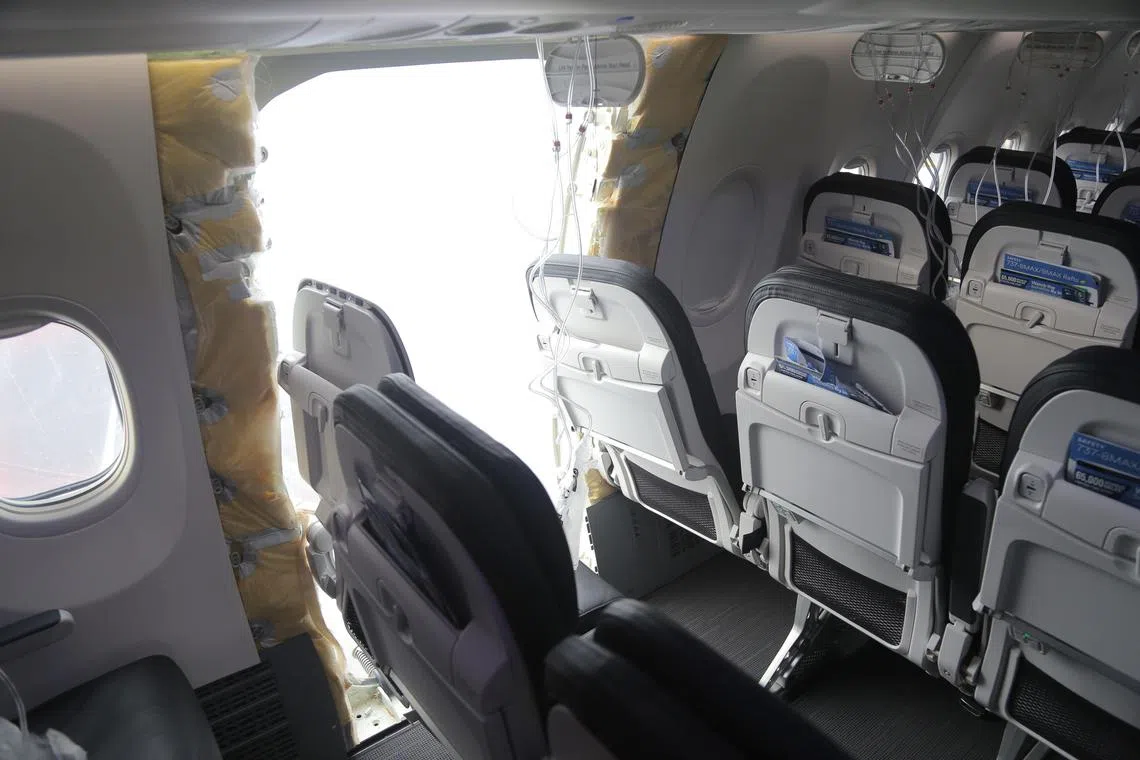US authorities say more Boeing 737 planes should get checks after Max 9 incident
Sign up now: Get ST's newsletters delivered to your inbox

This follows after the midair cabin blowout of a door plug on an eight-week-old Alaska Airlines Max 9 jet on Jan 5.
PHOTO: NYTIMES
Follow topic:
WASHINGTON - The United States Federal Aviation Administration (FAA) recommended late on Jan 21 that airlines operating Boeing 737-900ER jets inspect door plugs to ensure they are properly secured, after some operators reported unspecified issues with bolts upon inspections.
The recommendation follows the FAA’s grounding of 171 Boeing 737 Max 9 planes after the midair cabin blowout
The 737-900ER is not part of the newer Max fleet, but has the same door plug design that allows for the addition of an extra emergency exit door when carriers opt to install more seats.
The FAA issued a safety alert for operators disclosing that some airlines have conducted additional inspections on the 737-900ER mid-exit door plugs “and have noted findings with bolts during the maintenance inspections”.
It recommended that carriers perform key portions of a fuselage plug assembly maintenance procedure related to the four bolts used to secure the door plug to the airframe “as soon as possible”. Boeing first delivered the 737-900ER in 2007 and the last one in 2019.
Alaska Airlines and United Airlines, the only two US carriers that use Max 9, said in January they had found loose parts
The FAA on Jan 21 said Max 9 planes will remain grounded until it “is satisfied they are safe to return to service”.
United said on Jan 21 it was extending the cancellation of its Max 9 flights until Jan 26.
Alaska, whose Max 9 planes account for 20 per cent of its fleet, previously cancelled all flights through Jan 21. The airline did not immediately comment on how long it planned to extend cancellations.
In contrast to the Max 9 that experienced the door-plug issue, which was a new plane with a low number of flights, Boeing 737-900ER aircraft have more than 11 million hours of operation and 3.9 million flight cycles. The FAA said the door plug “has not been an issue with this model”.
Both United and Alaska said they had begun inspections of the door plugs on their 737-900ER fleets.
United, which has 136 737-900ER aircraft, expects the inspections “to be completed in the next few days without disruption to our customers”.
Alaska said its inspections began several days ago, and it has “had no findings to date and expects to complete the remainder of our 900ER fleet without disruption to our operations”.
Delta Air Lines, which operates the 900ER, said it had “elected to take proactive measures to inspect our 737-900ER fleet” and does not anticipate any operational impacts.
Globally, the three US carriers operate the vast majority of the 737-900ERs with the door plugs.
On Jan 17, the FAA said inspections of an initial group of 40 Boeing 737 MAX 9 jets had been completed, a key hurdle to eventually ungrounding the model. The FAA is continuing to review data from those inspections before deciding when the planes can resume flights.
FAA administrator Mike Whitaker told Reuters in January the FAA is “going through a process to work out how to restore confidence in the integrity of these plug doors”.
US National Transportation Safety Board chair Jennifer Homendy said last week the investigative agency would be looking at numerous records related to the door plug. She said it is unclear if the bolts on the Alaska Airlines jet were properly secured, or if they were actually installed at all. REUTERS

